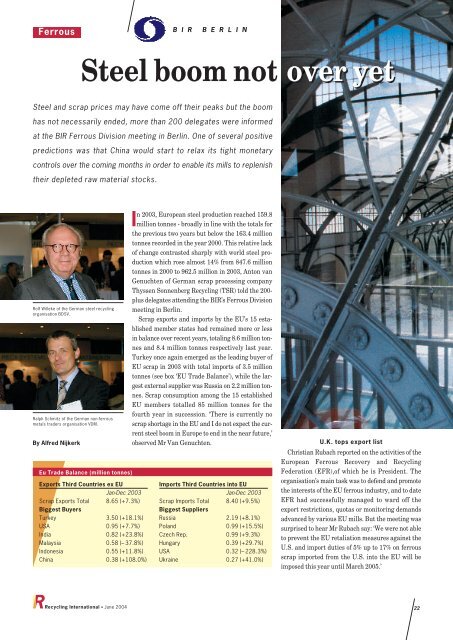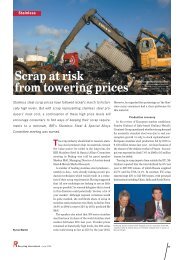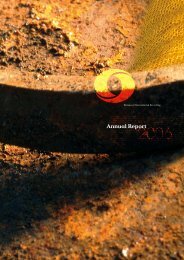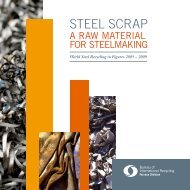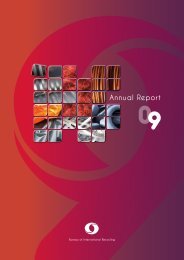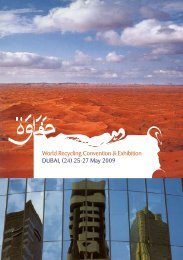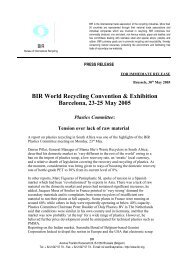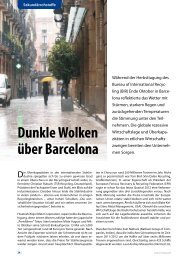You also want an ePaper? Increase the reach of your titles
YUMPU automatically turns print PDFs into web optimized ePapers that Google loves.
Ferrous<br />
B I R B E R L I N<br />
Steel boom not over yet<br />
Steel and scrap prices may have come off their peaks but the boom<br />
has not necessarily ended, more than 200 delegates were informed<br />
at the <strong>BIR</strong> Ferrous Division meeting in Berlin. One of several positive<br />
predictions was that China would start to relax its tight monetary<br />
controls over the coming months in order to enable its mills to replenish<br />
their depleted raw material stocks.<br />
Rolf Willeke of the German steel recycling<br />
organisation BDSV.<br />
Ralph Schmitz of the German non-ferrous<br />
metals traders organisation VDM.<br />
By Alfred Nijkerk<br />
Eu Trade Balance (million tonnes)<br />
Exports Third Countries ex EU<br />
Jan-Dec 2003<br />
Scrap Exports Total 8.65 (+7.3%)<br />
Biggest Buyers<br />
Turkey 3.50 (+18.1%)<br />
USA 0.95 (+7.7%)<br />
India 0.82 (+23.8%)<br />
Malaysia 0.58 (– 37.8%)<br />
Indonesia 0.55 (+11.8%)<br />
China 0.38 (+108.0%)<br />
In 2003, European steel production reached 159.8<br />
million tonnes - broadly in line with the totals for<br />
the previous two years but below the 163.4 million<br />
tonnes recorded in the year 2000. This relative lack<br />
of change contrasted sharply with world steel production<br />
which rose almost 14% from 847.6 million<br />
tonnes in 2000 to 962.5 million in 2003, Anton van<br />
Genuchten of German scrap processing company<br />
Thyssen Sonnenberg Recycling (TSR) told the 200-<br />
plus delegates attending the <strong>BIR</strong>’s Ferrous Division<br />
meeting in Berlin.<br />
Scrap exports and imports by the EU’s 15 established<br />
member states had remained more or less<br />
in balance over recent years, totaling 8.6 million tonnes<br />
and 8.4 million tonnes respectively last year.<br />
Turkey once again emerged as the leading buyer of<br />
EU scrap in 2003 with total imports of 3.5 million<br />
tonnes (see box ‘EU Trade Balance’), while the largest<br />
external supplier was Russia on 2.2 million tonnes.<br />
Scrap consumption among the 15 established<br />
EU members totalled 85 million tonnes for the<br />
fourth year in succession. ‘There is currently no<br />
scrap shortage in the EU and I do not expect the current<br />
steel boom in Europe to end in the near future,’<br />
observed Mr Van Genuchten.<br />
Imports Third Countries into EU<br />
Jan-Dec 2003<br />
Scrap Imports Total 8.40 (+9.5%)<br />
Biggest Suppliers<br />
Russia 2.19 (+8.1%)<br />
Poland 0.99 (+15.5%)<br />
Czech Rep. 0.99 (+9.3%)<br />
Hungary 0.39 (+29.7%)<br />
USA 0.32 (– 228.3%)<br />
Ukraine 0.27 (+41.0%)<br />
U.K. tops export list<br />
Christian Rubach reported on the activities of the<br />
European Ferrous Recovery and Recycling<br />
Federation (EFR),of which he is President. The<br />
organisation’s main task was to defend and promote<br />
the interests of the EU ferrous industry, and to date<br />
EFR had successfully managed to ward off the<br />
export restrictions, quotas or monitoring demands<br />
advanced by various EU mills. But the meeting was<br />
surprised to hear Mr Rubach say: ‘We were not able<br />
to prevent the EU retaliation measures against the<br />
U.S. and import duties of 5% up to 17% on ferrous<br />
scrap imported from the U.S. into the EU will be<br />
imposed this year until March 2005.’<br />
Recycling International • June 2004 22
B I R B E R L I N<br />
According to Colin Iles of EMR, the U.K. is currently<br />
the EU’s largest scrap exporter: last year, the<br />
country shipped almost 4 million tonnes overseas -<br />
equivalent to 47% of total EU exports. Inter-EU trade<br />
in scrap amounted to 20.8 million tonnes in 2003,<br />
he added. Ruggero Alocci of Italy said his country<br />
was one of the world’s largest importers of scrap in<br />
buying more than 4 million tonnes per annum. Italy<br />
produces 60% of its steel in scrap-fed electric arc furnaces<br />
(EAFs) compared to the EU average of 40%.<br />
According to Denis Ilatovsky of Mair, one of<br />
Russia’s largest scrap traders/processors, scrap collection<br />
in Russia reached 7.7 million tonnes in the<br />
first four months of 2004 - an increase of 42% over<br />
From this station in Berlin, which was built in 1865, trains once departed<br />
for Hamburg. Today, it is the home of the museum for contemporary art.<br />
From left: Alan Goldstein of AMG Resources; former <strong>BIR</strong> Environment<br />
Committee President Patrick Neenan; and John Crabb of Australia.<br />
the same period last year. Scrap exports increased<br />
by a factor of 2.3 to total 3.3 million tonnes. Of this,<br />
1.4 million tonnes was exported through the Baltic<br />
sea ports, 1.3 million tonnes through Black Sea and<br />
Sea of Azov ports, and 400 000 tonnes through Far<br />
East ports. Mr Ilatovsky noted: ‘Exports are limited<br />
to about 12 million tonnes, due to limited port<br />
capacities. In order not to be deprived of scrap, mills<br />
in Russia paid more for domestic scrap than export<br />
prices in April, thus creating large stocks.’ He predicted<br />
that scrap collection in 2004 would reach 26<br />
to 27 million tonnes while exports would achieve a<br />
maximum of 12 million tonnes. High domestic<br />
transport costs made melting steel in electric arc<br />
furnaces more economic than exporting material<br />
sometimes over thousands of miles to the ports.<br />
Thus, Russia’s scrap exports could fall within a few<br />
years to the extent that it could become a net importer,<br />
Mr Ilatovsky concluded.<br />
Record prices in South East Asia<br />
In his report on the Pacific Rim market, Jeremy<br />
Sutcliffe of Sims Group Australia cited record prices<br />
of US$ 350 per tonne in South East Asia this year.<br />
Even allowing for recent heavy falls, prices were<br />
still significantly higher than 12 months earlier.<br />
Mr Sutcliffe dealt with the key question of why<br />
China was so quiet, listing among other reasons the<br />
attempts by the country’s central government to cool<br />
down the economy, including severe restrictions on<br />
loans to expand steelmaking capacity. Power shortages<br />
and healthy stocks of both imported and<br />
domestic scrap were also mentioned. These conditions<br />
had forced EAF mills to operate at substantially<br />
lower capacities and was directly affecting the supply<br />
and demand of steel scrap. Nevertheless, China<br />
imported 3.2 million tonnes of scrap in the first quar-<br />
Steel in a global<br />
economy<br />
Guest speaker at the <strong>BIR</strong><br />
Ferrous Division meeting in<br />
Berlin was Prof. Dr Dieter<br />
Ameling, President of the<br />
German steel federation.<br />
Providing an excellent overview<br />
of the world steel situation, he<br />
underlined the spectacular<br />
increase in China’s steel production<br />
and gave forecasts for<br />
the year 2007. The apparent per<br />
capita utilisation rate of crude<br />
steel differed widely around the<br />
world, it was noted, with India<br />
lagging well behind and China<br />
rapidly gaining ground.<br />
According to Prof. Dr<br />
Ameling, worldwide scrap input<br />
was currently around 400 million<br />
tonnes per annum but recycling<br />
share as a percentage of<br />
crude steel production had been<br />
declining as a result of China’s<br />
decision to invest largely in integrated<br />
mills rather than electric<br />
arc furnaces. In 2002, steel production<br />
totalled 903 million tonnes<br />
while scrap input amounted<br />
to 383 million or 42.4%.<br />
Prof. Dr Ameling also gave<br />
an overview of the established<br />
15 EU member countries, in<br />
which he showed foreign scrap<br />
trade and compared the explosion<br />
in hot metal/D<strong>RI</strong>/scrap prices<br />
to the slower rise in steel<br />
prices.<br />
Guest Speaker Prof Dr Dieter Ameling,<br />
President of the German Steel Federation.<br />
Recycling International • June 2004 23
B I R B E R L I N<br />
China<br />
Apparent Utilization<br />
kg Crude Steel<br />
per Capita<br />
Selected Countries<br />
1000<br />
600<br />
400<br />
300<br />
200<br />
100<br />
60<br />
40<br />
30<br />
20<br />
10<br />
6<br />
4<br />
3<br />
2<br />
India<br />
Asia (excl. Japan/China)<br />
Japan<br />
China<br />
USA<br />
Germany<br />
South Korea<br />
1<br />
50 60 70 80 90 00 10<br />
Million t:<br />
World Crude Steel Production by Region<br />
(Share in %)<br />
189<br />
2004: 1020 million t*<br />
*estimated<br />
2.8%<br />
0.4<br />
2.6<br />
18.6<br />
5.6%<br />
3.1<br />
595 770<br />
15.6<br />
26.4<br />
23.0<br />
14.4<br />
965<br />
22.2<br />
22.9<br />
11.5<br />
14.1<br />
12.6<br />
48.1<br />
26.3<br />
19.3<br />
16.7<br />
27.4<br />
1950 1970 1990 2003<br />
China<br />
Apparent<br />
Utilization<br />
(Crude Steel)<br />
and<br />
Crude Steel<br />
Production<br />
EU acceding<br />
countries<br />
Other<br />
Europe<br />
CIS<br />
8.6<br />
14.3<br />
29.0<br />
14.4<br />
Foreign Trade of the EU 15<br />
(without domestic trade) 2003<br />
China<br />
3.169 166 3 378 7 2.907<br />
17<br />
475<br />
1.633<br />
2.546<br />
Crude steel in Mt<br />
360<br />
340<br />
320<br />
300<br />
Apparant utilization<br />
280<br />
260<br />
240<br />
220<br />
200<br />
180<br />
160<br />
140<br />
120<br />
EU-15<br />
Export of steel scrap: 8.648<br />
Imports of steel scrap : 8.490<br />
Net exports: 158<br />
Consumption: ca. 87.000<br />
3.499<br />
in 1.000 t<br />
Turkey<br />
42<br />
Crude steel<br />
production<br />
257<br />
345<br />
949<br />
745<br />
Other<br />
Countries<br />
China<br />
Japan<br />
Eastern Europe<br />
And CIS<br />
NAFTA<br />
EU 15<br />
∆+133 Mt ^= 33 Mt/a<br />
∆+27.2 Mt ^= 6.8 Mt/a<br />
100<br />
4 years 4 years<br />
80<br />
95 97 99 01 03 05<br />
Asia without<br />
China<br />
North America<br />
Others<br />
155<br />
Forescast<br />
Euro-<br />
Consult<br />
1999<br />
From Left:<br />
Colin Iles of the<br />
U.K., Christian<br />
Rubach of Germany,<br />
Ruggero Alocci of<br />
Italy and Ikbal<br />
Nathani of India.<br />
Dr Peter Schmöle,<br />
Manager of Crude<br />
Iron Production at<br />
the German<br />
ThyssenKrupp Stahl<br />
(TKS) steel mills in<br />
Germany.<br />
ter this year compared to 1.7 million tonnes during<br />
the same period last year.<br />
Korean imports of deep-sea cargoes have dropped<br />
due to strong domestic availability of steel scrap at<br />
considerably lower prices. The country’s steel production<br />
increased year on year by 4.5% in the first quarter<br />
of 2004. Weaker domestic prices in Japan had substantially<br />
increased scrap exports, further depressing<br />
prices in the region, according to Mr Sutcliffe.<br />
It was remarkable, he suggested, that the price<br />
difference between pig iron and ferrous scrap<br />
remained substantial and abnormal. And he also<br />
observed that the fundamentals which had led to<br />
the escalation in ferrous scrap prices were still in<br />
place, leading him to predict that<br />
ferrous scrap prices would stabilise<br />
shortly and that a new ‘resistance<br />
level’ would be established.<br />
Ikbal Nathani of India spoke of a fastgrowing<br />
steel industry in his country<br />
and continuing growth in ferrous<br />
scrap imports, despite an import duty<br />
of 5% on melting scrap. There was a<br />
15% duty on re-rollable scrap and on<br />
ships for demolition, he pointed out.<br />
Large volumes of scrap from the<br />
Middle East and Africa, as well as<br />
from Europe, were continuing to<br />
arrive in India in containers, with almost every<br />
shredder operator in Europe offering shredded<br />
scrap in this way to avoid crane discharge problems<br />
and congestion difficulties. Besides, the freight rate<br />
appeared to be lower.<br />
India’s steel industry had enjoyed a bumper year<br />
and had been running at 110-120% of installed<br />
capacity, according to Mr Nathani’s report. Steel<br />
demand was increasing rapidly and could reach 110<br />
million tonnes by 2010. Per capita steel consumption<br />
was still very low at only 30 kg per head compared<br />
to 150 kg in China and 460 kg in the U.S.<br />
Recycling International • June 2004 24
B I R B E R L I N<br />
Scrap was now being used even in some blast furnaces<br />
and the proportion of scrap feed would shortly<br />
be increased from 5% to 15%.<br />
Production costs rise in the U.S.<br />
Robert Philip of Hugo Neu Schnitzer in the U.S.,<br />
who was re-elected in Berlin for another two-year<br />
term as the Ferrous Division’s President, reported<br />
on the situation in his home market. He observed:<br />
‘Unlike prior economic recoveries, the dramatic rise<br />
of production costs due to the rise of commodities<br />
pricing could be passed along to the mills’ consumers<br />
via surcharges. But now that domestic scrap<br />
prices have backed off the Spring 2004 highs, these<br />
same mills are struggling to justify to their customers<br />
why a parallel reduction in the surcharges is<br />
not occurring.’ He predicted that China would reemerge<br />
as a strong buyer of scrap, but perhaps in a<br />
more ‘graduated’ manner than previously.<br />
Denis Mittleman of Hugo Neu Schnitzer remarked<br />
that whereas U.S. steel prices were perhaps the<br />
lowest in the world some six to eight months ago,<br />
they were now among the highest, with heavy plates<br />
at just under US$ 1000 per net ton and hot rolled<br />
coil at around US$ 650 per ton.<br />
The coke shortage had provoked a general increase<br />
in demand for scrap and for low residual scrap,<br />
pig iron and HBI/D<strong>RI</strong> especially. Strong containerised<br />
shipments of scrap had also been seen, he added.<br />
As in China and other countries, the U.S. was continuing<br />
to experience a serious shortage of railcar<br />
equipment and a reduction in shipments of up to 70%.<br />
Mr Mittleman ended by predicting that, over the<br />
coming months, China would start to relax its tight<br />
monetary controls in order to enable its mills to<br />
replenish their depleted raw material stocks. He<br />
also anticipated that CIF prices of under US$ 200 in<br />
Turkey and of below US$ 220 in Asia were unsustainable<br />
and would eventually move upwards again.<br />
General Director Herman Voskamp (left) and President Johan van<br />
Peperzeel of the Dutch Metal Recycling Federation.<br />
Shredder Committee<br />
Jens Hempel-Hansen of Denmark was<br />
unveiled as the new Chairman of <strong>BIR</strong>’s<br />
Shredder Committee in succession to<br />
Tony Bird of the U.K., who has chaired<br />
the committee for many years but has<br />
now stepped down following his election<br />
as <strong>BIR</strong> Treasurer.<br />
Ahead of the Berlin convention, the<br />
committee had drafted a comprehensive,<br />
country-by-country list of shredder operators.<br />
This indicated that there were 756<br />
automobile shredders across five continents<br />
as against 712 in the year 2000. At<br />
first glance, this did not suggest spectacular<br />
growth but, as Mr Bird observed,<br />
the trend in the U.S., Japan and Europe<br />
was to replace smaller shredders of less<br />
than 2000 HP with larger models of 3000<br />
to 10 000 HP. The Shredder<br />
Committee had identified<br />
234 automobile shredders<br />
in the U.S./Canada and 187<br />
in Japan, whereas China<br />
and Russia were thought to<br />
have only three and five<br />
shredders respectively.<br />
<strong>BIR</strong>’s Environmental and<br />
Technical Director Ross<br />
Bartley presented an update<br />
on the activities of the<br />
European Shredder Group<br />
(ESG) of the European<br />
Ferrous Recovery and<br />
Recycling Federation (EFR). In monitoring<br />
the EU’s ELV Directive, the organisation<br />
was rather concerned, he said, that implementation<br />
was not homogeneous, that<br />
timetables and targets differed, that some<br />
systems were funded whereas others were<br />
not, and that technical requirements often<br />
varied. There had also been complaints<br />
about lack of enforcement and about the<br />
data gathering burden.<br />
According to Mr Bird, ESG was also<br />
concerned about bans in various countries<br />
on the landfilling of automobile<br />
shredder residue (ASR).<br />
Dr Peter Schmöle, Manager of Crude<br />
Iron Production at the German Thyssen-<br />
Krupp Stahl (TKS) steel mills, gave a<br />
presentation on the requirements on ASR<br />
for injection into blast furnaces. In co-operation<br />
with other integrated mills in<br />
Germany, TKS has undertaken a study on<br />
the feasibility and requirements of adding<br />
ASR to traditional blast furnace feed. A<br />
trial is under way at the 12 000 tonnes a<br />
day TKS blast furnace in the German<br />
town of Schwelgern. In this process, ores<br />
(lumps, fines and sinters) enter the top of a<br />
blast furnace at a rate of 1600 kg per tonne<br />
of hot metal produced, together with<br />
coking coal (300 kg per tonne of hot metal).<br />
At the bottom of the furnace, hot wind is<br />
blown together with reducing agents such<br />
as pulverised coal (180 kg per tonne of hot<br />
metal), oil or natural gas. The total<br />
amount of reducing agents is some 475 kg<br />
per tonne of liquid iron produced.<br />
Because Anthony Bird of the U.K. (left) was elected as<br />
<strong>BIR</strong>’s new Treasurer, he stepped down as Chairman of<br />
the Shredder Committee. He was succeeded by Jens<br />
Hempel-Hansen of Denmark (right). In the centre is Rolf<br />
Willeke of Germany.<br />
To date, various operators in and outside<br />
of Germany have already added prepared<br />
old plastics to their blast furnaces<br />
and so the addition of ASR is also thought<br />
likely to be possible. But elements such<br />
as zinc, lead, alkali oxides and chlorine<br />
are allowed only in very limited quantities,<br />
while sulphur, phosphorus, copper,<br />
chromium, nickel and vanadium represent<br />
unwanted elements. ‘If the percentages<br />
of these “contaminants” in ironmaking<br />
can be held below certain standards,<br />
ASR could be a good feed in blast furnaces,’<br />
Dr Schmöle concluded.<br />
Recycling International • June 2004 25


